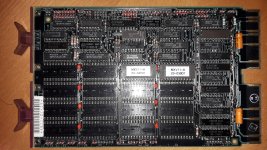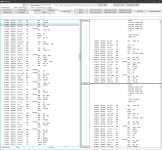daver2
10k Member
I have downloaded the 23-039D1 and 23-040D1 ROM images and looked at the first few entries of them:
15C0 = 012700
00E0 = 000340
8D00 = 106400
0005 = 000005
These four (4) words should appear at 773000 but seem to appear at 773010 (i.e. there either appears to be an offset applied or one of the address bits is 'wonky').
The other possibility is that the MXV11-A boot ROMs deliberately 'scramble' the address lines (both in the ROM programming and the board) and this causes the data to appear at the correct locations. The MRV11-C will not implement the same 'scrambling'. I don't know whether the MXV11-A actually does this 'trick', but I know other boot boards that do...
Perhaps check a few more words yourself?
Dave
15C0 = 012700
00E0 = 000340
8D00 = 106400
0005 = 000005
These four (4) words should appear at 773000 but seem to appear at 773010 (i.e. there either appears to be an offset applied or one of the address bits is 'wonky').
The other possibility is that the MXV11-A boot ROMs deliberately 'scramble' the address lines (both in the ROM programming and the board) and this causes the data to appear at the correct locations. The MRV11-C will not implement the same 'scrambling'. I don't know whether the MXV11-A actually does this 'trick', but I know other boot boards that do...
Perhaps check a few more words yourself?
Dave



